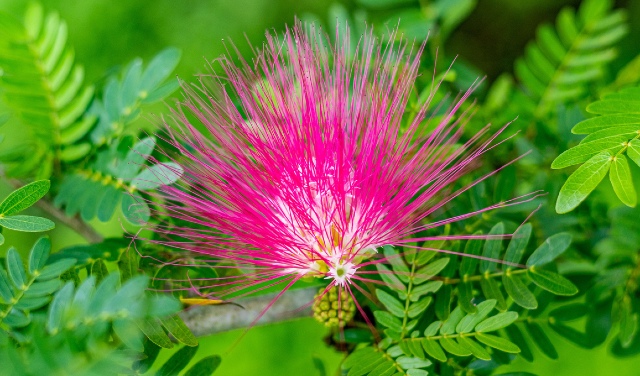With my windows wide open, an intoxicating scent filled my car as I pulled into my friend’s driveway. I got out of my car and found the fragrant breeze was a blessing as I walked towards this magnificent tree! Mimosa gathering is something I truly enjoy as spring slides into summer. I will readily reprioritize my schedule once in its full glory of dainty, cotton candy scented blooms. Just the thought of the blooms invokes the magical delicate tingling of taste buds even when not in season.
For many, Mimosa is met with mixed feelings since it is invasive to North America, especially in parts of the southeast United States. Many foragers love Mimosa yet there are probably more who would rather see it gone – and I get it. Yet at the same time, why not embrace all that it has to offer. With invasive plants there is no concern of over-harvesting and for those of us who are foragers (or herbalists), most people are happy to let us have access to these unwanted plants or trees. I will add that as much as I adore working with Mimosa, I could never plant it intentionally knowing how detrimental it can be to native habitats.
Sitting under this beautiful grandmother tree is always a source of solace, a reset from the day-to-day life and usually enjoyed with great company and conversation. Crafting edible and medicinal goodies from the gathering is a time filled with love and enjoyment.
Origin and Some Cool Facts
The Silk Tree, or Mimosa (Albizia julibrissin), is a member of the Fabaceae (legume) family. This drought-tolerant tree is native of Asia and was brought to the United States in 1745. It was cultivated as an ornamental tree due to its fragrant and showy flowers. This tree is now invasive in much of the Southeastern United States. The genus name, Albizia, honors Filippo degli Albizzia, an Italian naturalist, who introduced the Silk Tree to Tuscany, Italy. The species name, julibrissin, comes from the Persian word “gul-i brisham,” which means silk flower.
This tree is used as food and also has medicinal properties. The edible parts are young leaves and the flowers. Flowers, leaves and the stem bark have the medicinal properties.
Uses for Mimosa
Mimosa has been greatly valued for centuries in traditional Chinese medicine. As a botanical is has helped to improve mood, decrease anxiety and bring a sense of calm. It is so highly valued in Asia.
It is reported to be high in antioxidants which can help sooth rashes, blemishes, acne and psoriasis. It can also aid with wounds especially those with nerve, tissue and muscle damage. Some other benefits include easing irritability, insomnia, reduce inflammation in sinuses, aid regulation of digestion, as well as much more.
The characterization of this tree’s seed oil shows that it could be successfully used for making soap, hair shampoo and in the formulation of UV protectors in cosmetic. Also, the high level of polyunsaturated fatty acids makes it quite desirable in terms of nutrition, and might be an acceptable substitute for highly polyunsaturated oils such soybean oil in diets.
What has captured some attention is that there is some research that indicates a specific extract of the Mimosa tree has an anti-glycation effect on the skin. (Glycation is a process that results in the skin losing its elasticity leading to the development of wrinkles.) The extract helps to repair the structure of damaged skin proteins, lessens wrinkles, reduces dark circles under the eyes, and helps to get rid of puffy eyes. It improves blood circulation to the skin and prevents the formation of age spots. This extract is used in many skincare products.
As food, the leaves can be added to soups and stews. They contain calcium, potassium, sodium, magnesium, sulphur, and zinc. The flowers can be used for tea, infused in honey, to make jelly, syrup, and even gummies. Although dried flowers can be used, these are best when used fresh.
Like so many other edible invasives out there, you can harvest guilt-free and use as much as you can!
Sources:





Thank you for this information that is totally amazing. Who would have thought this tree was loaded with goodness! Can’t wait to try the recipes – after winter!!
Those flowers are so gorgeous.
After weeks of crappy weather and basically no sun this photo is a joy to just stare at!!